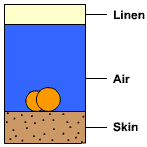The Chemical Origins of the Shroud of Turin
Created | Updated Mar 23, 2010

Only if the active principle is highly unstable would its smooth vertical transport give rise to a modulated image
So said Dr Allan Mills, specialist in Physics and Astronomy at Leicester University, in that strange lingo that extremely learned people use when they're trying to explain something that's actually fairly simple. He was talking about his theory of the process used to create the image that we see on the famous Shroud of Turin1. Here we explain a scientific theory on how it happened.
Imagine that you have the body of a man lying at rest, covered with a sheet of linen. The oxygen in the air around us has twin atoms. Individual atoms do not normally exist in an unpaired state. The lactic acid layer on the skin causes the atoms to split. The individual atoms absorb energy from this process, and then rise up on the smooth convection airflow from the warm human body. The single atom condition is naturally untenable and each individual atom will look to pair up with the first other atom it comes across. So, by the time the atoms have travelled 40mm almost all of them will have returned to their natural paired state.
When the lone atoms re-merge with atoms on the surface of fibrils on the sheet of linen, the energy that they have previously stored is released. This causes the fibre to change colour. And this is because the fibre is effectively burnt, or scorched, to a depth of one molecule.
On the surface of the fibre a curious chain reaction occurs. As a single atom 'runs off' with the partner of another atom, and that atom steals another's partner, and so on, the energy that was created is transferred between atoms, and the scorching effect takes place again with each transfer. As the distance between the body and the surface of the linen grows the number of unstable, 'divorced' atoms decreases because more of them have found partners, to a point where at 40mm there will be relatively few bachelor atoms left. Because the atoms are moving upwards in a regular, non-turbulent fashion, the result is a photograph of the subject below, but created by unstable oxygen atoms rather than light photons. The areas of linen closest to the subject will suffer the most scorching and hence be the darkest areas.
And that is how the image was created. In itself the process is fairly simple, and is not much of a mystery at all. The mystery is more concerned with the circumstances that caused the linen to be covering the subject in the first place, and more importantly, who the subject was. But before we can do this, having first shown how the image was created, we need to discover when the image was created.
Carbon Dating
All green plants maintain a constant level of carbon 14 while alive. Once the plant dies, the carbon 14 starts to deteriorate at a precise rate that is well documented and measurable against graphs known as calibration curves. From the remaining carbon 14 the date that the plant died can be obtained, but this is subject to a number of years either side of a certain date, say sixty years either side of the year obtained from the results.
Consent to Test the Shroud
In 1986, the Roman Catholic Church finally consented to allow carbon dating to take place on the Shroud. Previously they had ruled that carbon dating would cause too much damage to the shroud, but scientific advancements had been made to the extent that a dating could be made from using just 5mg of cloth. So the technophobic establishment - how else can you describe an organisation that only lifted its public decry of the theories of both Galileo and Darwin in the last decade? - agreed that the tests could take place.
Samples were lifted from the Shroud on 21 April, 1988, and were given to representatives of laboratories from Arizona, Oxford and Zurich. To ensure accuracy, control samples were given from pieces of cloth of known origin, but the origins of the control samples were not made known to the participants. The four pieces of cloth were:
A piece taken from the shroud.
A piece taken from a Christian tomb at Qadr Obrim, dated to the 11th or 12th Century.
A piece taken from a tomb at Thebes dated to AD75.
Threads taken from a piece at the Basilica of St Maximin, known to date from the mid-13th Century.
The three labs agreed not to exchange results until they had all submitted them first to the British Museum. The results, together with a full write-up of the experiments and the calibration curves were published in an article in the magazine, Nature. All details were given so that any doubting Thomases could check the methodology and results of the experiment. The results were, that with 95% confidence, that the flax plants used to create the Shroud of Turin only came in to existence between AD1260 and AD1390.

